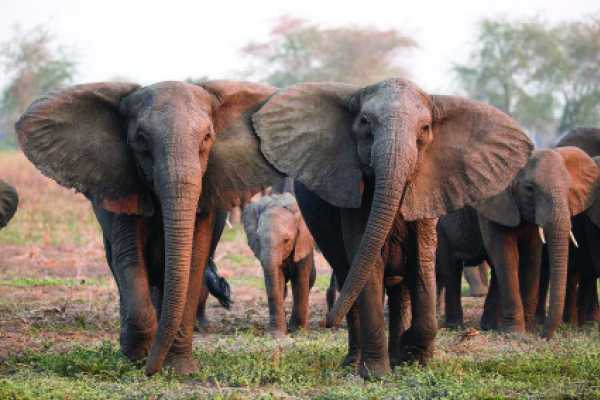Communities demand stake in elephant management strategy
Any dialogue on human-wildlife conflict, especially elephants-human conflict cannot bear any positive results if the affected communities who encounter the wrath of these jumbos on a daily basis are not part of decision making. Residents in areas where these animals roam around feel that those who engage in such dialogue without engaging them would just be out on holiday.
If it was according to their will the residents say they could have long poisoned water holes in the area to eliminate elephants. Onkatsitswe Sedimo resides in Lesoma Village about 20KM from Kasane, the tourism area where Kasane Summit 2019 was held early this month.He commutes to Kasane on a daily basis to work. On the night of the interview with this publication he was travelling at sunset to Kasane to do some grocery shopping. Even by the the bus stop Sedimo ensures he is in an area where he could see any of the wildlife from a distance.
They have come to live with the situation but got worried when he sees a group of journalists who seem to be reckless with their surroundings.He explains that life for them is hell. They cannot just travel as they wish at night because that could be the end of someone’s life. Even some children in Lesoma Village travel between 500metres and 1KM to school in a dense forest.
He revealed that due to the increase of elephant population in their area there is competition for space. The elephants, movement would be because of water and other climate change conditions. Sedimo explained that many lose their homes while others fall victim and become disabled after their encounter with elephants, hippos and buffaloes. Even during the day everyone has to be looking over their shoulders as anything can happen.
He is however surprised that right in the middle of Kasane experts and government officials from five countries that make up Kavango Zambezi Transfontier Conservation Area (KAZA TFCA) have gathered to discuss how to deal with the situation that has been tormenting them for years now. He is of the view that what is happening is just talk and no implementation that will benefit the communities.Sankuyo Tshwaragano Trust representative Mischief Puo said the summit cannot talk about the elephants far away from them. He stated that culling or reducing the number of elephants is more practical to deal with elephant management.
He pointed out that communities must be made part of the management strategy for sustainable use of resources.“We need positive incentive packages for the community. Involvement of communities is very minimal. We must make informed decisions, which is why we also need proper statistics. “I support the lifting of the hunting ban. We need sustainable development for the benefit of the elephants and the communities,” he stated.Experts however believe that a compromise can be reached where elephants and humans can co-exist. Tom Milliken pointed out that the animals can be preserved and at the same time have the community benefit.
He is of the view that Asia presents a lucrative market hence elephants have been a target for ivory trading. He said China more especially has been a market for ivory for years. He however said the country should be commended for cracking on notorious syndicates that deal in illegal ivory trade. According to Milliken there are also people from Africa who illegally transport ivory by concealing it in clothes.Member of Parliament for Okavango Bagalatia Arone said when dealing with the Botswana situation experts must avoid looking at countries far away. He said whether there is a market or not is not an issue but the issues are “our people are losing their lives. People are losing their livestock and crops.”
According to the MP (whose constituency is affected by a high number of elephant population and elephants-human conflict) there is need to talk about sustainable ways of dealing with the situation at hand. Arone revealed that if hunting should be brought back so be it. The MP who is also Minister of Basic Education was also part of the Presidential Task Team that was appointed to consult Batswana on the hunting ban. According to Arone, having been born and bred in an area of these flora and fauna there is no need for him to have studied animals to know what has to be done. He said experts should not impose their findings on the communities. “I grew up in the Delta and there is no need to have findings imposed on us. The experts need to come to us and dialogue with people with indigenous knowledge to understand our situation.
“You cannot have a balance when the population of elephants is that much. We want to get rid of the old ones which are even not productive so that we help the little ones to get vegetation,” argued Arone. According to Holly Dublin whether the countries are far or not, whatever happens will impact on the African elephant. She explained that indeed there is need for sustainable ways of dealing with the matter where both elephants and humans will benefit. She stated that there is an opportunity for co-existence in the KAZA area.
“We have to develop co-existence landscape where elephants thrive and people thrive. There are some positive things for KAZA. There is massive infrastructure plans for this area and we need to think as to how the duo can live alongside each other. “KAZA is rich in land and water. There are traders and there is no how we can leave the issue and not talk about it. Trophy hunting is not going to reduce the numbers, we need development scenarios that are workable,” she said.Professor Joseph Mbaiwa from the Okavango Research Institute said there is an escalation of elephants’ population. He said the other contributing factor to the increase is the 2014 hunting ban. The professor stated that the experience has been that there has been damage to crops, livestock, boreholes and killing of people by elephants.
According to Prof Mbaiwa this has been happening in the past five years. He explained that benefits for communities in the affected areas have been low. “There has been negative attitude by communities towards elephants. If there is negative attitude that is not good and there will never be participation in terms of conservation by the communities. “In terms of Community Based Natural Resources Management, only Namibia is doing good in the KAZA area. We want communities to participate. Why could we not have communities form partnerships where they can package their products and services and ensure communities benefit meaningfully,” wondered Prof Mbaiwa.
Southern Africa is home to the largest number of elephants on the continent, with 75 percent of the elephants found within the KAZA TFCA. The estimated number of elephants in areas surveyed in the last ten years in Southern Africa is 293, 447.Elephant numbers in Southern Africa have declined by almost 30, 000 on the basis of updated estimates contained in the 2016 African Elephant Status Report.






